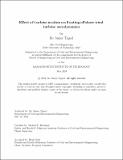Effect of turbine motion on floating off shore wind turbine aerodynamics
Author(s)
Tignol, Bo Junior
DownloadThesis PDF (9.447Mb)
Advisor
Howland, Michael F.
Terms of use
Metadata
Show full item recordAbstract
The quest to meet renewable energy targets and anticipate future energy consumption growth has driven the continuous development of wind energy system design and its push for larger and more efficient wind turbines, especially in offshore environments. Floating Offshore Wind Turbines (FOWTs) are a promising alternative for capturing high wind energy potential in more difficult offshore environments that pose challenges to traditional bottom-fixed turbines. Yet, the understanding of FOWT behaviour under dynamic floating motion-induced translational and rotational degrees of freedom remains a significant and important challenge. Indeed, there is considerable inconsistency with regards to the interpretation of FOWT behaviour under floating motion. This thesis aims to evaluate the influence of surge and pitch motions on the aerodynamic behaviour of FOWT through the interpretation of several modeling approaches and their differences. Various surge and pitch amplitude and frequency ranges are considered, and two large eddy simulation (LES) approaches, along with a simplified analytical model, are assessed with regards to their predictions of the axial induction, induced velocity, power production, and wake velocities. It was found that there is generally close agreement between surging inflow and surging actuator disk LES simulations, with a difference in time-averaged power production no larger than 1.8% for any of the investigated cases, confirming the hypothesized similarity between these two methods to simulate turbines in kinematic motion. Furthermore, it was found that, although the simplified analytical model performed well at low frequency surge motions, it exhibited increasing underprediction of power production with increasing frequency. As for the pitch cases, the model exhibited low error compared to LES simulations across the amplitudes investigated. Moreover, unlike the variability in the surging data, the pitching LES exhibited less variations with surging frequencies, which suggests that the analytical model maintains better predictive capability across a diverse range of pitching motions. Looking forward, the results of this study suggest the need for continued in-depth evaluation of additional LES parameters such as the tip-speed ratio and thrust coefficient, along with validation with the development of an analytical model that can capture the observed frequency dependence. Finally, future work should also further hone in on the inclusion of LES at different freestream wind and surge and pitch combinations to explore the potential formation of complex wake states, as well as the investigation of in-sync and out-of-sync joint pitch-and-surge cases to explore the occurrence of any nonlinear aerodynamic interactions.
Date issued
2024-05Department
Massachusetts Institute of Technology. Department of Civil and Environmental EngineeringPublisher
Massachusetts Institute of Technology